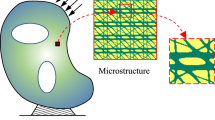Abstract
Topology optimization consists in finding the spatial distribution of a given total volume of material for the resulting structure to have some optimal property, for instance, maximization of structural stiffness or maximization of the fundamental eigenfrequency. In this paper a Genetic Algorithm (GA) employing a representation method based on trees is developed to generate initial feasible individuals that remain feasible upon crossover and mutation and as such do not require any repairing operator to ensure feasibility. Several application examples are studied involving the topology optimization of structures where the objective functions is the maximization of the stiffness and the maximization of the first and the second eigenfrequencies of a plate, all cases having a prescribed material volume constraint.
Similar content being viewed by others
References
ABAQUS (2003) ABAQUS, version 6.4. HKS, Pawtucket
Abuali FN, Wainwright RL, Schoenefeld DA (1995) Determinant factorization: a new encoding scheme for spanning trees applied to the probabilistic minimum spanning tree problem. In: Eshelman LJ (ed) Proc. of the sixth int. conf. on genetic algorithms. Morgan Kaufmann, San Francisco, pp 470–477
Aguilar Madeira JF, Rodrigues HC, Pina HL (2005) Multi-objective optimization of structures topology by genetic algorithms. Adv Eng Softw 36(1):21–28
Aguilar Madeira JF, Rodrigues HC, Pina HL (2006) Multi-objective topology optimization of structures using genetic algorithms with chromosome repairing. Struct Multidisc Optim 32(1):31–39
Baldwin MJ (1896) A new factor in evolution. Am Nat 30(354):441–451
Baldwin MJ (1897) Organic selection. Science, New Series 5(121):634–636
Bean JC (1994) Genetic algorithms and random keys for sequencing and optimization. ORSA J Comput 6:154–160
Bendsøe MP (1995) Optimization of structural topology, shape, and material. Springer, Heidelberg
Cormen TH, Leiserson CE, Rivest RL (1990) Introduction to algorithms. MIT, Cambridge
Diaz AR, Kikuchi N (1992) Solutions to shape and topology eigenvalue optimization problems using a homogenization method. Int J Numer Method Eng 35:1487–1502
Du J, Olhoff N (2007) Topological design of freely vibrating continuum structures for maximum values of simple and multiple eigenfrequencies and frequency gaps. Struct Multidisc Optim 34(2):91–110
Gross JL, Yellen J (2006) Graph theory and its applications. Chapman & Hall, London
Hajela P (1993) Genetic algorithms in structural topology optimization. In: Bendsøe MP, Soares CM (eds) Topology design of structures. Kluwer, Deventer, pp 117–133
Krog LA, Olhoff N (1999) Optimum topology and reinforcement design of disk and plate structures with multiple stiffness and eigenfrequency objectives. Comput Struct 72:535–563
Kruskal JB (1956) On the shortest spanning subtree and the traveling salesman problem. Proc Am Math Soc 7:48–50
Ma ZD, Kikuchi N, Cheng HC (1994) Structural design for obtaining desired eigenfrequencies by using the topology and shape optimization method. Comput Syst Eng 5:77–89
Ma ZD, Kikuchi N, Cheng HC (1995) Topological design for vibrating structures. Comput Methods Appl Mech Eng 121:259–280
Norman BA, Smith AE (1997) Random keys genetic algorithm with adaptive penalty function for optimization of constrained facility layout problems. In: 4 Proceedings of the fourth conference on evolutionary computation. IEEE, Piscataway, pp 407–411
Palmer CC, Kershenbaum A (1997) Representing trees in genetic algorithms. In: Back T, Fogel DB, Michalewicz Z (eds) Handbook of evolutionary computation, pages G1.3. Institute of Physics Publishing and Oxford University Press, Bristol, pp 1–8
Pedersen NL (2000) Maximization of eigenvalues using topology optimization. Struct Multidiscipl Optim 20:2–11
Rothlauf F, Goldberg DE, Heinzl A (2002) Network random keys: a tree representation scheme for genetic and evolutionary algorithms. Evol Comput 10:75–97
Rozvany G (2001) Aims, scope, methods, history and unifield terminology of computer-aided topology optimization in structural mechanics. Struct Multidiscipl Optim 21:90–108
Simo JC, Rifai MS (1990) A class of assumed strain methods and the method of incompatible modes. Int J Numer Methods Eng 29:1595–1638
TOPOPT: research group headed by Sigmund O. and Bendsøe MP (2008) Homepage. www.topopt.dtu.dk
Wall M (1996) GAlib: a C++ library of genetic algorithm components. Massachusetts Institute of Technology, Cambridge
Wang SY, Tai K, Wang MY (2006) An enhanced genetic algorithm for structural topology optimization. Int J Numer Methods Eng 65:18–44
Wilson EL, Taylor RL, Doherty WP, Ghaboussi J (1973) Incompatible displacement models. In: Fenves SF, Perrone N, Robinson AR, Schnobrich WC (eds) Numerical and computer models in structural mechanics. Academic, New York
Author information
Authors and Affiliations
Corresponding author
Rights and permissions
About this article
Cite this article
Madeira, J.F.A., Pina, H.L. & Rodrigues, H.C. GA topology optimization using random keys for tree encoding of structures. Struct Multidisc Optim 40, 227–240 (2010). https://doi.org/10.1007/s00158-008-0353-1
Received:
Revised:
Accepted:
Published:
Issue Date:
DOI: https://doi.org/10.1007/s00158-008-0353-1




